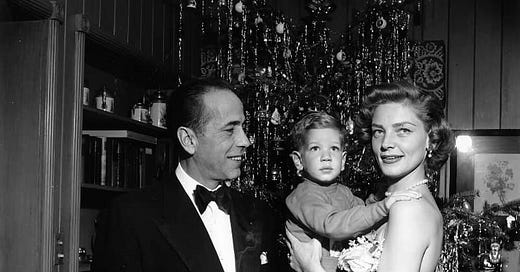“Here’s looking at you, kid.”
— Casablanca

Humphrey Bogart, one of the most iconic actors in cinematic history, remains a cultural touchstone for his sharp wit, effortless coolness, and unforgettable performances. His life was as compelling as the characters he portrayed on screen. From his early days as the rebellious son of a wealthy family to his rise as one of the greatest actors of all time, Bogart’s legacy is now etched in Hollywood history.
Table of Contents: Early Life and Background / World War I / Acting Career / Hollywood Success / Iconic Roles / Meeting Lauren / Other Roles / Personal Life / Later years
If you aren’t subscribed yet, hit the subscribe button below to receive the Adorable Stories every weekend, directly in your inbox:
Early Life and Background
Humphrey DeForest Bogart was born on December 25th, 1899 to Belmont DeForest Bogart, a wealthy cardiopulmonary surgeon, and Maud Humphrey, a successful commercial illustrator and a militant suffragist (she was a descendant of Mayflower passenger John Howland).
The name “Bogart” derives from the Dutch surname “Bogaert”, meaning “orchard.”
The Bogarts divided their time between an Upper West Side apartment in New York City, and a cottage on a 55-acre estate on Canandaigua Lake in upstate New York. When he was young, Humphrey’s group of friends at the lake used to put on plays to entertain friends and family members.
Young Humphrey inherited from his father a fondness for fishing, a lifelong love of boating, and an attraction to strong-willed women.
He had a privileged upbringing, but struggled to meet his parents’ expectations. A poor student, he was sent to the prestigious Phillips Academy in Andover, Massachusetts, in preparation for Yale University.
However, his rebellious nature led him to fail four out of six classes and finally to his expulsion for disciplinary reasons in 2018 (although the Phillips Academy website claims he was in the graduating class of 1920).
World War I
“At eighteen, war was great stuff. Paris! Sexy French girls! Hot damn!”
— Humphrey Bogart
After being expelled by Phillips Academy, Humphrey Bogart enlisted in the United States Navy in the spring of 1918, near the end of World War I.
Bogart was recorded as a model sailor, who spent most of his sea time after the armistice ferrying troops back to the USA from Europe.
Acting Career
“I was born to be indolent and this was the softest of rackets.”
— Humphrey Bogart
Following his naval service during World War I, Humphrey Bogart returned to New York City without clear direction. He took on various odd jobs, including working as a shipper and bond salesman, but neither satisfied him.
His entry into the entertainment world came through family connections—Bogart’s father was friends with theatrical producer William A. Brady, who gave him a job as a stage manager in the early 1920s.
Bogart became intrigued by acting and began appearing in small roles in Broadway productions.
Preferring to learn by doing, Humphrey Bogart never took acting lessons.
Early in his career, he often played small romantic or comedic characters, but his performances were generally unremarkable: success eluded him for much of the 20s where he was often cast in forgettable roles, usually as the second or third lead, and his career stagnated.
In 1935, Bogart starred in the Broadway production of The Petrified Forest as Duke Mantee, a menacing and cold-blooded fugitive based loosely on gangster John Dillinger.
His performance was riveting, and caught the attention of critics and audiences alike.
When Warner Bros. decided to adapt the play for the screen, Humphrey Bogart’s co-star, Leslie Howard, insisted that Bogart reprise his role. The studio initially wanted a bigger name for the part, but Howard refused to participate in the film without Bogart.
This act of loyalty from his friend would have a profound impact on Bogart’s career, and he remained deeply grateful to Howard for championing him, so much that he named his only daughter, Leslie Howard Bogart, after him in 1952.
The 1936 film adaptation of The Petrified Forest was a turning point. Bogart’s portrayal of Duke Mantee—intense, brooding, and charismatic—won widespread acclaim and showcased his ability to command the screen. From that point on, he left New York and remained in Los Angeles, steadily building his reputation as a screen actor.
Hollywood Success
“In the first 34 pictures for Warner’s, I was shot in 12, electrocuted or hanged in 8, and was a jailbird in 9”
— Humphrey Bogart
Despite the success of the film, Warner Bros. continued to typecast him only as a villain or supporting character.
Throughout the late 1930s, Bogart appeared in a string of B-movies, often playing gangsters, henchmen, or prison inmates.
Films like “Angels with Dirty Faces” (1938) and “The Roaring Twenties” (1939) allowed him to refine his tough-guy persona, but he remained in the shadow of bigger stars like James Cagney and Edward G. Robinson. He averaged a film every two months between 1936 and 1940, sometimes working on two films at the same time.
Iconic Roles
The 1940s marked the golden era of Humphrey Bogart’s career, as he transitioned from supporting roles to becoming one of Hollywood’s most sought-after leading men.
His breakthrough as a leading actor came with “High Sierra” (1941), a crime drama where he played Roy Earle, an aging and world-weary gangster.
The film’s success not only solidified his status as a bankable star but also proved that he could carry a film on his shoulders as a complex and multifaceted protagonist.
Later in 1941, Bogart starred in “The Maltese Falcon,” directed by legendary John Huston.
This landmark film noir cemented his reputation as a Hollywood heavyweight.
Playing private detective Sam Spade, Bogart delivered a performance that was equal parts cynical, shrewd, and charismatic.
The film, based on Dashiell Hammett’s novel of the same name, is still widely regarded as one of the defining works of the genre, and Bogart’s portrayal of Spade remains one of his most enduring roles. His sharp dialogue, cool demeanor, and commanding presence made him a natural fit for the morally ambiguous world of film noir.
In 1941, at the outset of WWII, Humphrey Bogart attempted to enlist again in the Navy but was deemed too old to serve and was rejected.
In 1942, Bogart reached the pinnacle of his career with his portrayal of Rick Blaine in “Casablanca.”
The film, directed by Michael Curtiz, is often hailed as one of the greatest movies of all time. Bogart’s Rick is a nightclub owner in wartime Morocco, torn between rekindling his romance with the unforgettable Ilsa Lund (played by Ingrid Bergman) and aiding her husband, a resistance leader, in escaping the Nazis. The role allowed Bogart to blend toughness with vulnerability, cynicism with selflessness, and romance with heartbreak.
It was his most nuanced performance to date, earning him his first Academy Award nomination for Best Actor.
Lines like “Here’s looking at you, kid” and “We’ll always have Paris” became immortal in cinematic history, along with Rick’s iconic white tuxedo, his trench coat and fedora.
Casablanca not only launched Bogart into the stratosphere of stardom but also remains a cornerstone of his legendary career to this day.
Meeting Lauren
Humphrey Bogart’s pairing with actress Lauren Bacall in “To Have and Have Not” (1944) marked another milestone. Directed by Howard Hawks and loosely based on an Ernest Hemingway novel, the film is remembered for the chemistry between Bogart and Bacall.
Lauren Bacall, just 19 years old at the time, delivered the now-famous line:
“You know how to whistle, don’t you, Steve? You just put your lips together and blow.”
Off-screen, Bogart (at the time still married with actress Mayo Methot) and Bacall quickly fell in love, and their relationship became one of Hollywood’s most celebrated romances.
The duo went on to star in three more films together: “The Big Sleep” (1946), “Dark Passage” (1947), and “Key Largo” (1948), all of which showcased their electric on-screen dynamic.
Other Roles
Throughout the 1950s, Bogart continued to deliver compelling performances. In “In a Lonely Place” (1950), he played a troubled screenwriter suspected of murder, a role that many critics consider one of his finest. The film was darker and more introspective than his earlier works, showing once again his ability to tackle complex, flawed characters.
Bogart’s other iconic roles include “Treasure of the Sierra Madre” (1948), and the celebrated “Sabrina” (1954), a romantic comedy where he starred opposite Audrey Hepburn and William Holden, showing his lighter, more romantic acting side.
In 1951, Bogart delivered another career-defining performance in “The African Queen.” Directed again by John Huston and co-starring Katharine Hepburn, the film was a departure from his usual urban roles.
Set on a river in East Africa during World War I, Bogart played Charlie Allnut, a scruffy, hard-drinking boat captain who reluctantly teams up with Hepburn’s prim and proper missionary to take on a German gunboat.
The role allowed Bogart to show a more humorous and tender side, and his performance earned him his first and only Academy Award for Best Actor.
The film remains a classic, beloved for its adventurous spirit, sharp dialogue, and the remarkable chemistry between its two stars.
Bogart also impressed audiences in “The Caine Mutiny” (1954), playing the paranoid and unstable Captain Queeg. This performance earned him another Academy Award nomination.
Personal Life
Despite his tough on-screen persona, Bogart was known to have a vulnerable side, and his relationships were often complex and tumultuous.
He had four wives:
Helen Menken (1926–1927)
Bogart married stage actress Helen Menken on May 20th, 1926, but the union was short-lived. The couple divorced just over a year later in November 1927, reportedly due to personality clashes and a lack of compatibility. Their marriage ended amicably, and both moved on without public scandal. Menken went on to have a successful career in theater on her own.Mary Philips (1928–1937)
Bogart’s second wife, actress Mary Philips, shared his Broadway roots. The couple married on April 3rd, 1928, and their marriage lasted nearly a decade. Philips was ambitious about her own acting career and often traveled for work, which strained their relationship. Bogart’s move to Hollywood in the early 1930s further complicated things, as Philips chose to remain in New York to focus on theater. Their eventual divorce in 1937 was reportedly amicable.Mayo Methot (1938–1945)
Bogart’s third marriage, to actress Mayo Methot, was unfortunately infamous for its volatility. The couple wed on August 21st, 1938, and their fiery relationship soon earned them the nickname “The Battling Bogarts.” Both were known for their heavy drinking, and their frequent public and private arguments became tabloid fodder. Methot’s jealousy over Bogart’s rising Hollywood stardom and rumors of extramarital affairs added to their troubles. Despite their passionate beginnings, the marriage became increasingly toxic, and Bogart began seeking solace elsewhere. Their tumultuous relationship ended in divorce in 1945, shortly after Bogart fell in love with Lauren Bacall (see below).Lauren Bacall (1945–1957)
Bogart’s fourth and final marriage, to actress Lauren Bacall, was a stark contrast to his earlier relationships. The two met on the set of “To Have and Have Not” (1944) when Bacall was just 19 and Bogart was 44. Despite their 25-year age difference, they developed a deep romantic and intellectual connection. They married on May 21st, 1945, shortly after Bogart’s divorce from Mayo Methot. Together, they became one of Hollywood’s most admired couples, with Bacall referring to Bogart as her “great love.” The couple had two children: Stephen Humphrey Bogart (born 1949, named after Bogart’s character in To Have and Have Not) and Leslie Howard Bogart (born 1952, named after actor Leslie Howard, who had helped Bogart land his breakthrough role in The Petrified Forest). Their partnership is remembered as one of the great love stories of Hollywood’s Golden Age.The Humphrey Bogart and Lauren Bacall lived in a stunning home located at 232 South Mapleton Drive in the affluent Holmby Hills neighborhood of Los Angeles, California.
Later Years
A heavy smoker and drinker, Bogart developed esophageal cancer by the mid 50s.
He did not talk about his health problems with anyone and decided to visit a doctor only in late January 1956, after considerable persuasion from his then wife, Lauren Bacall.
The disease worsened and several weeks later, on March 1st, 1956 Bogart underwent urgent surgery to remove his esophagus, two lymph nodes and a rib. The surgery was unsuccessful, and chemotherapy followed.
Although he became too weak to walk up and down stairs, he joked despite the pain:
“Put me in the dumbwaiter and I’ll ride down to the first floor in style.”
Frank Sinatra, Katharine Hepburn, and Spencer Tracy visited him on January 13th, 1957.
In an interview, Katharine Hepburn later recalled:
Spence patted him on the shoulder and said, “Goodnight, Bogie.” Bogie turned his eyes to Spence very quietly and with a sweet smile covered Spence’s hand with his own and said, “Goodbye, Spence.” Spence’s heart stood still. He understood.
Humphrey Bogart lapsed into a coma shortly after his friends visit at the hospital, and died the following day, on January 14th, 1957. At the time of his death, he weighed only 80 pounds (36 kg).
—Alberto @
Do you know anyone who would love to read this Adorable Story? Show your support by sharing Adorable Times’ Newsletter and earn rewards for your referrals.








